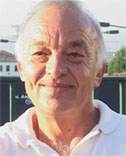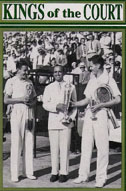The Classical Forehand
By Ed Atkinson
Second only to the serve, the forehand drive is the most potent weapon a player can develop. A powerful forehand can be put in play more often than the backhand drive because it is easy and natural for a player to run around his backhand and hit a forehand.
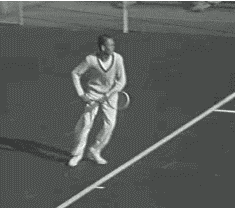
It appears that the classical forehand disappeared from the modern tennis scene some time ago, although Sampras, Becker, and Stitch all incorporated some of its elements. In the pure form of such masters as Ellsworth Vines, Don Budge, Jack Kramer, and Pancho Gonzalez, the classic forehand was an unsurpassed powerful and flexible weapon. As a model, it is also far better suited for recreational and lower level competitive players because of its simplicity.
For the first time on the web, you can study the elements of the greatest classical forehands in tennis history.
The Grip
The classic drive is hit with the Eastern grip which is created by holding the racket in your non-playing hand, so that the racket face is perpendicular to the court surface. Now "shake hands" with the racket handle with your playing hand. The bottom of the "V" formed by your forefinger and thumb should point directly up the racket handle.
This is the only grip which enables a player to hit the ball flat, with slice or with topspin, giving the stroke versatility no other grip can provide.
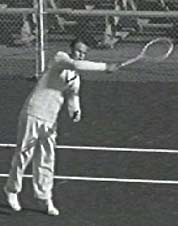 |
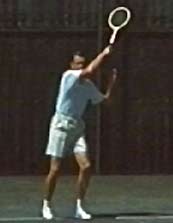 |
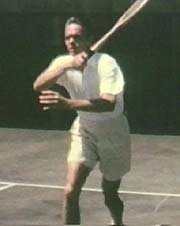 |
The Footwork
The feet (and with them the body) turn at the start of the stroke, so the right-handed player's left shoulder is pointed toward the net. Watch how this step and body turn initiate the racket preparation. The feet are about two feet apart and directly in line with each other. As the player is about to strike the ball, he steps forward with his left foot and transfers his weight forward.
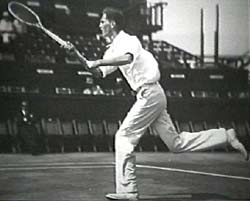
The optimum weight shift would include some slight pressure from the rear foot to add hip action to the shot. Jack Kramer mastered this latter technique and his opponents complained of having to return a bowling ball.
The Backswing
After the shoulder turn, the racket is taken back in a slight upward motion then dropped and the forward stroke is slightly upward giving the stroke natural topspin. The backswing and foreswing form a natural loop with the racket face staying perpendicular to the court throughout the stroke.
The racket head is raised only slightly above the shoulder at the highest point, and drops no lower than the hip.
The racket is never taken so far back that the opponent can see it behind the body. This is "the groove" a player can always refer to on days his timing is less than perfect.
How do you hit low balls without dropping the racket below the hip? The answer is simple - bend your knees!
The Forward Swing
The most common error made by players at every level is they don't hit the ball far enough out in front of them. The player should reach for the ball in front. This makes the weight shift automatic. The upper arm from the shoulder to the elbow should be between 90 and 45 degrees to the ground, depending on the player's position to the ball. The wrist is bent slightly backward.
The technical followthrough ends with the racket hand pointing to the opponent's baseline and the racket on edge or close to on edge with the court (not wrapped around the neck).
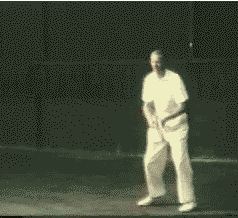
After passing through this extended followthrough position, the racket may move backward slightly over the left shoulder as the player enters the recovery phase for the next shot. This is very different than forehands with extreme grips in the modern game in which the followthrough wraps violently around the neck.
When hitting this shot, the left shoulder should stay pointed to the net for as long as possible. The rear foot remains in position behind the player rather than swerving around with the hit. Too much shoulder rotation too soon makes it impossible to hit the ball deep. This also drastically reduces the body weight behind the ball. Sacrificing body weight for arm speed is a losing proposition.
Conclusion
The classic Eastern forehand was developed and refined by a series of legendary players, starting with Bill Tilden and continuing from Ellsworth Vines through Don Budge, Jack Kramer and Pancho Gonzalez.
The first truly great forehand was Bill Johnston's western drive, which for a time made him almost invincible. But Bill Tilden analyzed this weapon and discovered that it did not fare well against a low slice, nor could Johnston hit a a forehand slice himself. Tilden laid the groundwork for the classic forehand, with the eastern grip - shot flexibility, and nuances were added by later players.



